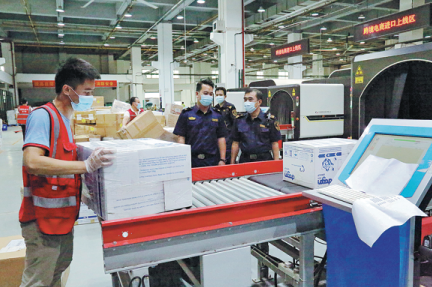
Customs streamlines e-commerce clearance
Nanning Customs in the Guangxi Zhuang autonomous region has introduced a slew of measures to support businesses in the China (Guangxi) Pilot Free Trade Zone.
The FTZ, which celebrated its first anniversary in August, has seen rising cross-border e-commerce transactions. Improving the efficiency of customs clearance is one of the key factors in promoting the growth of the sector, according to the local government.
For the first time in China, cross-border e-commerce goods for export are being checked at the same stage as international mail and express parcels.
The change can shorten the time of customs clearance for cross-border e-commerce goods from eight hours to about an hour.
Attracted by the premium customs service, 38 cross-border e-commerce businesses have settled in the FTZ area in the first 10 months of this year.
The area reported more than 1.36 billion yuan ($207 million) in cross-border e-commerce retail value, nearly double that of 2019.
Aimed at facilitating international trade, Nanning Customs has also introduced a two-step customs clearance model so that importers can receive their goods as quickly as possible.
Under the new model, importers in the Guangxi FTZ can pick up their goods simply by presenting their bills of lading-though customs declarations must be completed with more required documents and certificates within 14 days after the arrival of the vehicles or vessels carrying the goods.
Nanning Customs has also developed an online business certificate verification system, a one-stop service system for international trade that allows government departments to share information about companies and has more channels to inform companies of updated policies.
Carrying out financial reforms to promote the further opening-up of Guangxi is another key move in the region's FTZ construction.
Financial institutions have launched many new services and provided strong support for companies in the FTZ over the past year or so, the local government says.
As of the end of June, the Guangxi branch of Bank of Communications has served 1,214 enterprises in the Guangxi FTZ. The bank also introduced several online international financial services in early 2020 to serve companies' cross-border trading needs.
The Guangxi branch of Bank of Communications joined hands with the Nanning government in January to launch a "financial innovation lab" to test new policies and services.
To date, a series of new financial services have been launched. For example, the bank can now provide deposit, loan and foreign exchange services to nonresident account holders. A total of 12 nonresident accounts had been opened as of June.
In August, the Macao branch of Bank of Communications purchased bonds worth 10 million yuan that were issued by the Guangxi Zhuang autonomous region, marking a breakthrough in the bank's promotion of cross-border services in domestic currency.
The bank also promoted two-way, cross-border capital flows and helped companies reduce financing costs.

International packages at a postal service center integrating mail, express parcels and e-commerce deliveries are under the supervision of Nanning Customs. YU ZHUANGPENG/FOR CHINA DAILY




